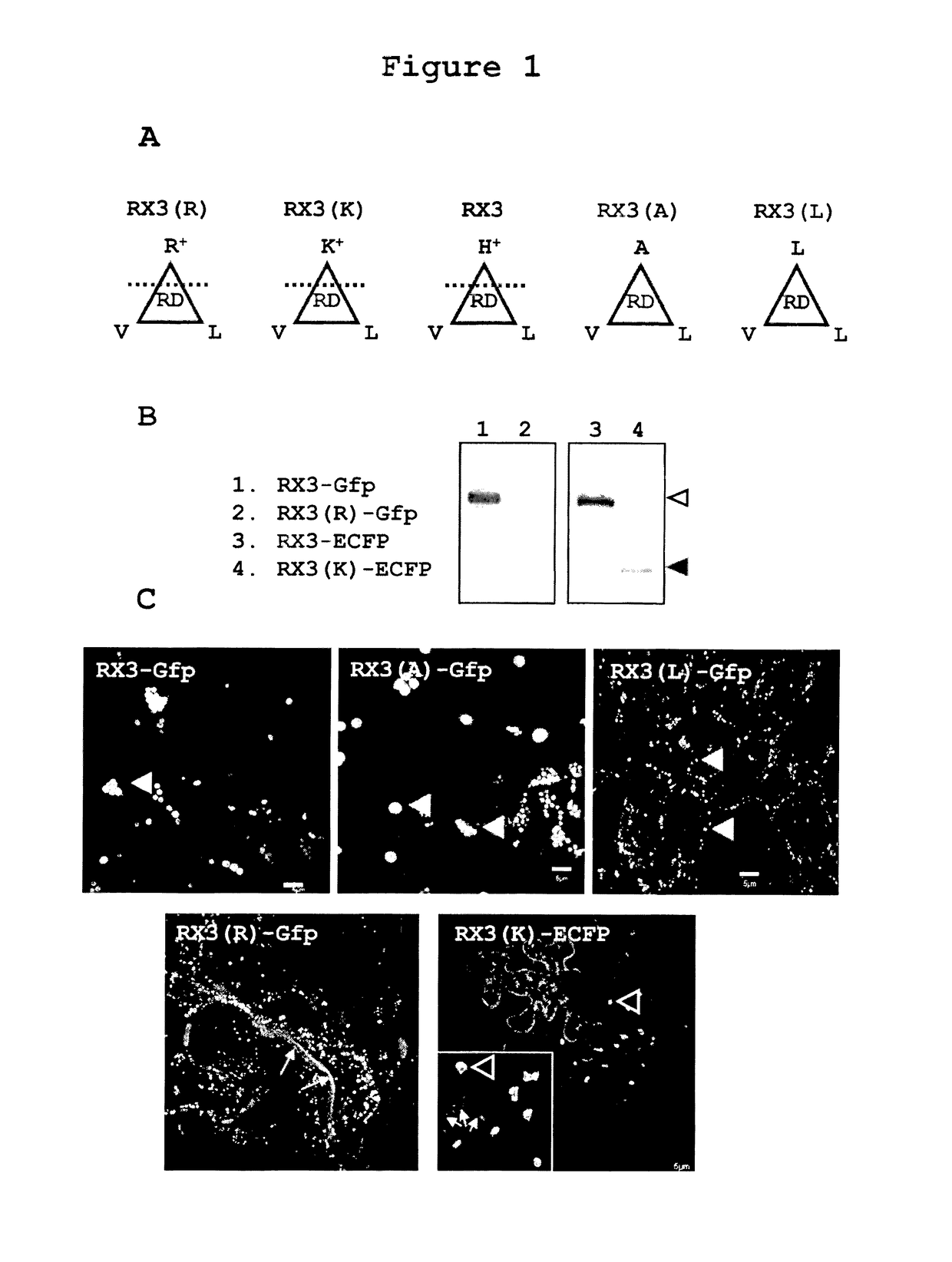Recombinant protein body-inducing polypeptides
a technology of recombinant protein and polypeptide, which is applied in the field of peptides, can solve the problems of not being able to meet the requirements for the formation of this type of organelle, the pbs in endosperm may not be sorted, and the pbs in other cells or tissues may not be sufficient, so as to reduce the allergenicity
- Summary
- Abstract
- Description
- Claims
- Application Information
AI Technical Summary
Benefits of technology
Problems solved by technology
Method used
Image
Examples
example 1
Accumulation of RX3-GFP, RX3(R)-GFP, RX3(K)-ECFP, RX3(A)-GFP and RX3(L)-GFP in RPBLAs of Transformed Tobacco Plants
[0239]It has been described that the amphipathicity of the repeat domain of RX3 is essential in self-assembly and RPBLAs formation (Ludevid et al., Plant Mol. Biol. (1984) 3:277-234; Kogan et al., J. Mol. Biol. (2001) 312:907-913). In order to characterize the importance of the amphipathicity on the capacity of RPBLAs induction, a set of RX3 tags fused to a reporter fluorescent protein (GFP or ECFP) were analyzed (FIG. 1A): the native RX3 with histidines (PPPVHL)6(PPPVHV)(PPPVHL) (SEQ ID NO:158) [RX3], two RX3 variants with an enhanced amphipathic character obtained by the substitution of the histidines by arginine (PPPVRL)×8 (SEQ ID NO:146) [RX3(R)] and lysine (PPPVKL)×8 (SEQ ID NO:147) [RX3(K)], and two RX3 variants with a fully hydrophobic RD where histidines were replaced by alanine (PPPVAL)×8 (SEQ ID NO:148) [RX3(A)] and leucine and (PPPVLL)×8 (SEQ ID NO:149) [RX3(...
example 2
Density Characterization of RPBLAs Induced by RX3-GFP, RX3(A)-GFP, and RX3(L)-GFP in Tobacco Plants
[0244]One characteristic of RPBLAs is their high density, which can be determined by step-density gradients (Torrent, BMC Biology 2009, 7:5). In the present study, Optiprep™ gradients were carried out by loading filtered plant homogenates under the following Optiprep™ step cushions:
[0245]
Optiprep ™Density%(g / mL)181.117301.175341.194381.214421.233461.252
[0246]Microsomes (ER, Golgi, etc.) sediment in fraction f18, the interphase above the low density cushion with 18% of Optiprep™. Typically, RPBLAs are denser than microsomes and are recovered from fractions denser than 26-28% of Optiprep™.
[0247]As shown in FIG. 2, when the homogenate of a tobacco plant expressing the fusion protein RX3-GFP was ultracentrifuged in the given step density gradient, as expected, most of the protein was recovered in the dense fractions f34 and f38. This result demonstrates that the fusion protein assembles ti...
example 3
Downstream Procedure for RPBLAs Isolation from Tobacco Plants by Low Speed Centrifugation
[0250]Density gradient centrifugation is an analytical procedure appropriate for RPBLAs density determination, but it is not suitable for purifying these organelles at large scale. A downstream process based on a simple centrifugation at a low speed and some washing steps of the sediment recovered (see experimental procedures) has been developed that permits the recovery of a clean RPBLA fraction.
[0251]This simple downstream process was applied to tobacco plants transformed with RX3-GFP and RX3(A)-GFP, and equivalent amounts of the different steps of the process were analyzed by western and SDS-PAGE stained by Coomassie blue. As shown in FIG. 3A, almost all of the fusion protein present in the corresponding homogenates (H0) was recovered in the RPBLAs fraction (wPB). The yield in both cases was similar and very high as no fusion protein is lost in the supernatant (SN) and washing step (Ws). This...
PUM
 Login to View More
Login to View More Abstract
Description
Claims
Application Information
 Login to View More
Login to View More - R&D
- Intellectual Property
- Life Sciences
- Materials
- Tech Scout
- Unparalleled Data Quality
- Higher Quality Content
- 60% Fewer Hallucinations
Browse by: Latest US Patents, China's latest patents, Technical Efficacy Thesaurus, Application Domain, Technology Topic, Popular Technical Reports.
© 2025 PatSnap. All rights reserved.Legal|Privacy policy|Modern Slavery Act Transparency Statement|Sitemap|About US| Contact US: help@patsnap.com



